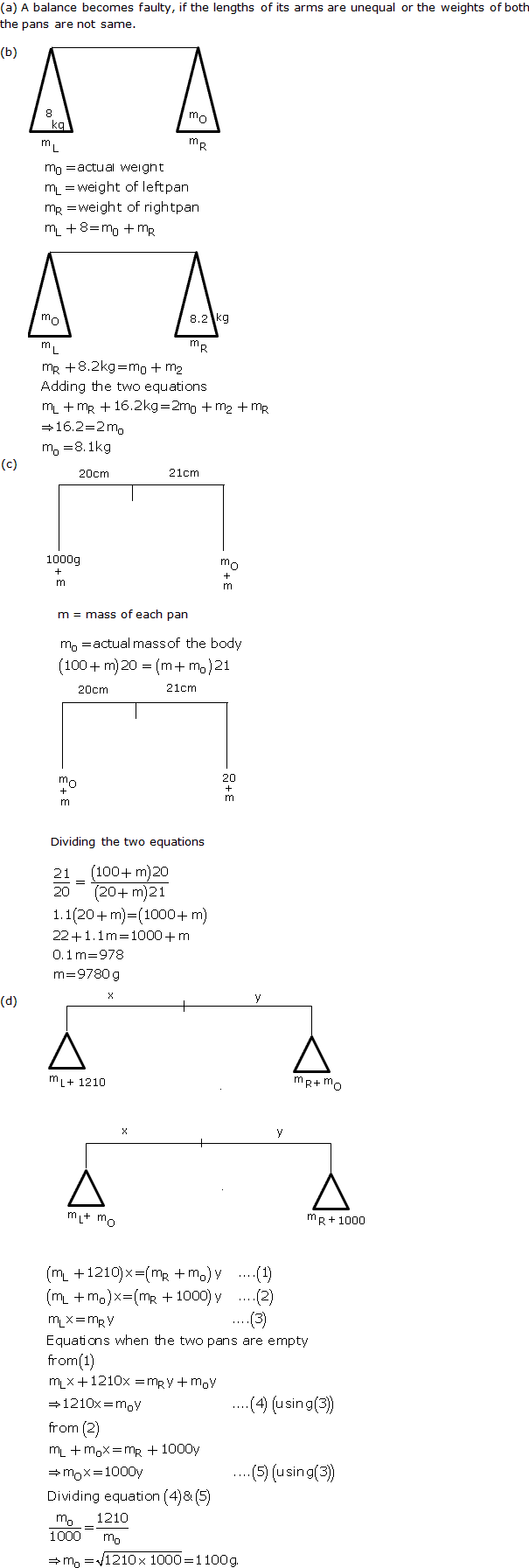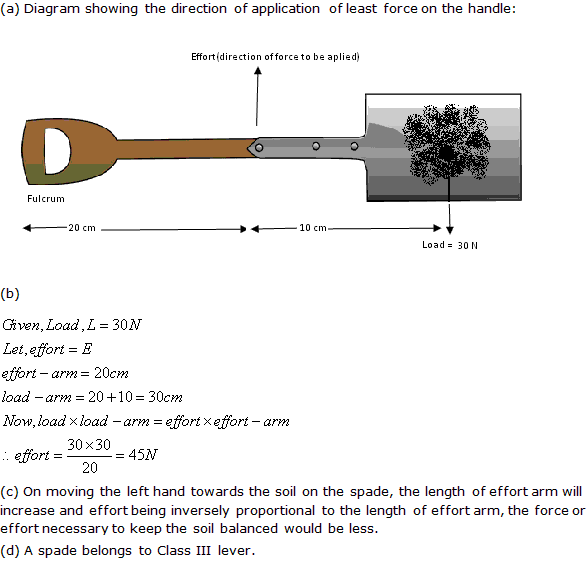Class 10 FRANK Solutions Physics Chapter 1 - Force, Work, Energy and Power - Exercises and MCQ
Practise Frank Solutions for ICSE Class 10 Physics Chapter 1 Force, Work, Energy and Power Exercises and MCQ to understand chapter concepts. Get accurate answers for textbook questions on our study portal and quickly revise concepts like simple machine, efficiency, lever, centre of gravity etc. Also, revise Physics formulae with step-wise solutions for problems based on moment of force, torque, moment of a couple and other concepts.
If you fear Physics questions, TopperLearning’s ICSE Class 10 Frank Solutions will come in handy during revision. You need not worry about correct answers as these solutions are created by Physics experts to ease your anxiety. To manage your Physics exam blues, practise Q&A from our Selina Solutions and solved question papers.
Force, Work, Energy and Power - Exercises and MCQ Exercise 56
Solution 1
Moment of a force = Force x perpendicular distance of the pivot from the force.
Its SI unit is newton-metre (Nm).
Solution 2
Solution 3
Solution 4
Solution 5
Solution 6
Solution 7
Solution 8
Solution 9
Solution 10

Solution 11

Solution 12
Solution 13
Solution 14
(i) Body's weight
(ii) Body's shape
Solution 15
Solution 16
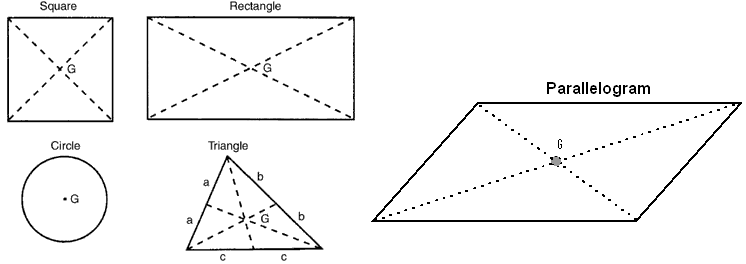
Force, Work, Energy and Power - Exercises and MCQ Exercise 57
Solution 17
It is not the same as the centrifugal force.
Solution 18
Torque may be defines as the turning effect produced by a force on a rigid body about a point, pivot or fulcrum. It is measured by the product of force and the perpendicular distance of the pivot from the line of action of force.
Solution 19
Couple is a pair of equal and opposite forces with different line of action. Moment of Couple is the rotational effect produced by a couple.
SI unit of couple is Nm. CGS unit is dyne-cm.
Solution 20
Examples of turning effect of force:
(i) Turning a steering wheel
(ii) Tightening a cap
Solution 21
Solution 22
Fnet = 0.
Static equilibrium is the situation where the object upon which the forces act is no moving.
The object is "static" hence the state of equilibrium gets its name.
Dynamic equilibrium is the situation where an object is in constant velocity motion.
{This object can't experience an acceleration which means Fnet >0}
Solution 23
Conditions for stable equilibrium:
(a) The body should have a broad base.
(b) Centre of gravity of the body should be as low as possible.
(c) Vertical line drawn from the centre of gravity should fall within the base of the support.
Solution 24
(b) If both the forces act at two different points of the body at a separation d then they constitute a torque whose value is given F x d.
Solution 25

Solution 26
Solution 27

Solution 28

Solution 29
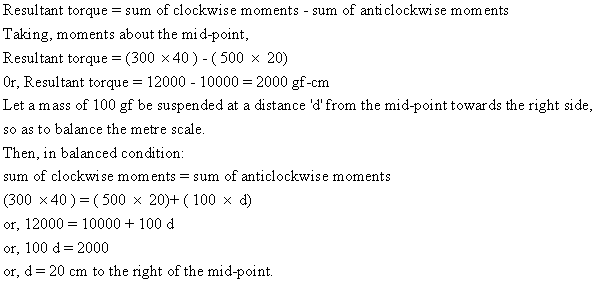
Solution 30

Solution 31
Conditions for stable equilibrium:
(a) The body should have a broad base.
(b) Centre of gravity of the body should be as low as possible.
(c) Vertical line drawn from the centre of gravity should fall within the base of the support.
Force, Work, Energy and Power - Exercises and MCQ Exercise 58
Solution 32
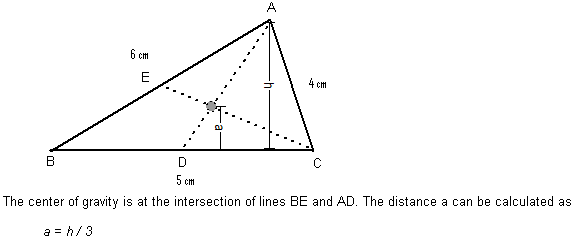
Solution 33
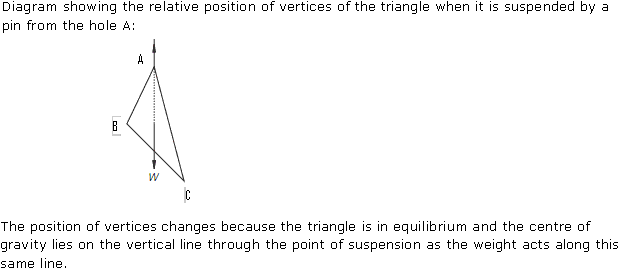
Solution 34
A boy standing on both legs has his COG in balanced position and is thus in stable equilibrium but a boy standing on one leg has his COG in unbalanced position which makes him quite unstable and hence it is easier to push him.
(ii) A man bends forward in order to keep himself in a stable equilibrium while climbing up a slope. By bending forward he increases the base of the support, so that the vertical line passing through his centre of gravity may still fall within the base.
(iii) When a truck is not fully loaded, its COG is at a high point and hence the turning moment of the weight is much greater, thus, the truck will be quite unstable and there are chances of toppling, when a truck takes a sharp turn.
(iv) When a man gets down from a moving train, his feet come to rest immediately, while the upper part of his body due to inertia of motion still remains in motion and consequently he leans in forward direction. The person while getting down of a train should run forward in the direction of the moving train to avoid fall.
(v) This is due to the fact that the body of the passenger is in the state of rest as long as the bus is at rest. When the bus starts, his feet acquire the velocity of the bus and come to motion with the moving bus, while the upper portion of his body due to inertia of rest tends to remain in the state of rest, resulting in his tendency to fall backwards.
Solution 35
Solution 36
Solution 37
(ii) We bend forward in order to keep ourselves in a stable equilibrium while climbing up a hill. By bending forward we increases the base of the support, so that the vertical line passing through our centre of gravity still falls within the base.
(iii) By keeping the legs apart, the base of the body broadens, thus the C.G. lowers and the body attains a more stable equilibrium.
(iv) Passengers are usually advised not to stand in the upper deck of the double deck bus. When the passengers are standing, the C.G. rises. This decreases the stability of the bus. When the passengers are sitting, the C.G. gets lowered and stability of the bus increases.
Solution 38

Solution 39
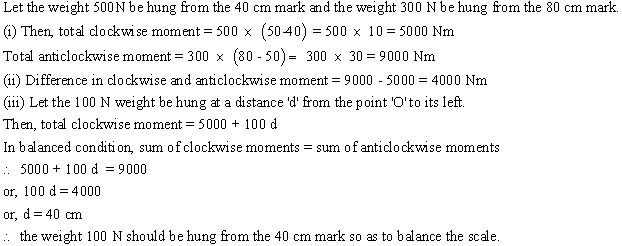
Solution 40

Force, Work, Energy and Power - Exercises and MCQ Exercise 59
Solution 41
It is equal to the product of force and the displacement of the point of application of the force in the direction of force.
The SI unit of work is 'joules' and the CGS unit is 'erg'.
Solution 42
(ii) [A]
(iii) [D]
(iv) [E]
(v) [B]
Solution 43

Solution 44
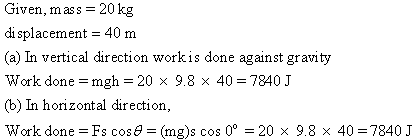
Solution 45
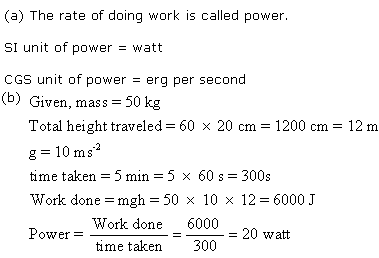
Solution 46
The SI unit of work is 'joules' and the CGS unit is 'erg'.
Solution 47
a.Weight of the body acting downwards
b.Normal reaction of the floor acting upwards
c.The centrifugal force acting on the body, acting upwards.
Weight of the body is due to gravitational force on the body acting downwards.
Normal reaction is the force that is exerted by the elevator floor in response to the force with which the body presses itself against the floor.
The centrifugal force here is fictious force that acts on the body in the direction opposite to the acceleration of the reference frame, here it is, the elevator floor. It is given by ma, where m is the mass of the body & a is the accelaration of the elevator floor. Centrifugal force is directed opposite to the acceleration of the elevator floor.
Weightlessness is the condition of the zero apparent weight.
When the acceleration of the elevator is such that the upward centrifugal force Fc completely balances the downward weight Wt. of the body, the resultant normal reaction (N =Fc - Wt.) of the body is reduce dto zero. That's whene the body on the elevator floor will experience the state of weightlessness.
Solution 48

Solution 49
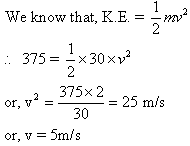
Solution 50

Solution 51
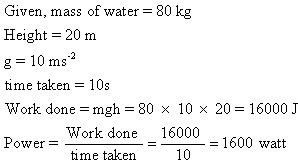
Solution 52

Solution 53
The SI unit of work is 'joules' and the CGS unit is 'erg'.
According to the law of conservation of energy, energy can neither be created nor be destroyed but can be transformed from one form to another. In other words, energy can be transformed from one form to another but the total amount of all the energies remain the same.
Solution 54
1. Solar energy: The energy radiated by the sun is called the solar energy. Inside the sun, energy is produced by nuclear fusion reaction. Solar energy cannot be used to do work directly, because it is too diffused and is not always uniformly available. However, a number of devices such as solar panels, solar cells etc. have been invented to make use of solar energy.
2. Heat energy: The energy released on burning coal, oil, wood or gas is the heat energy. The stem possesses heat energy it has capacity to do work.
3. Light energy: It is the form of energy in presence of which other objects are seen. The natural source of light energy is sun. Many other sources of heat energy also give light energy.
4. Chemical or fuel energy: The energy possessed by fossil fuels such as coal, petroleum and natural gas is called chemical energy or fuel energy. These fuels are formed from the decayed remains of dead plants and animals that lived millions of years ago. In the interior of earth, due to high pressure and temperature the remains slowly changed into fossil fuels.
5. Hydro energy: The energy possessed by fast moving water is called the hydro energy. This energy is used to generate electricity in hydroelectric power stations. For this, dams are built across the rivers high up in the hills to store water. Water is allowed to run down the pipes and the energy of running water is used to turn a turbine. The turbine drives generators to produce electrical energy.
6. Nuclear energy: The energy released during the processes of nuclear fission and fusion is called nuclear (or atomic) energy. In both these processes, there is loss in mass which converts into energy in accordance with Einstein's mass-energy relation, E =mc2.
Solution 55
Examples of potential energy:
(i) Water stored at a height in a reservoir.
(ii) A stretched spring.
(iii) A bent bow.
The energy possessed by a body by virtue of its motion is called kinetic energy.
Examples of kinetic energy:
(i) Air in motion has kinetic energy.
(ii) A swinging pendulum.
(iii) Moving hands of a clock.
Solution 56
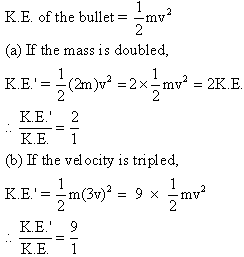
Solution 57

Solution 58
(b) Potential energy
(c) Kinetic energy
(d) Potential energy
(e) Kinetic energy
Force, Work, Energy and Power - Exercises and MCQ Exercise 60
Solution 59
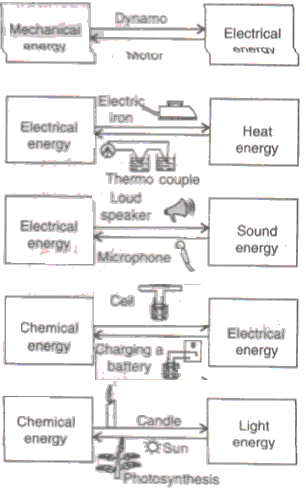
Solution 60

Solution 61
(b) Candle flame
(c) Dry cell
(d) Solar cell
(e) Electric iron
Solution 62

Solution 63
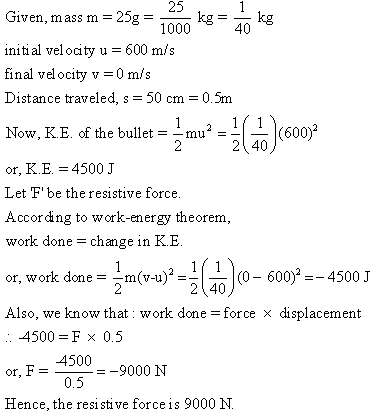
Solution 64
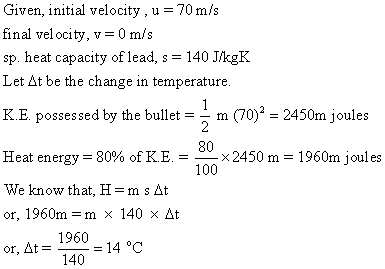
Solution 65
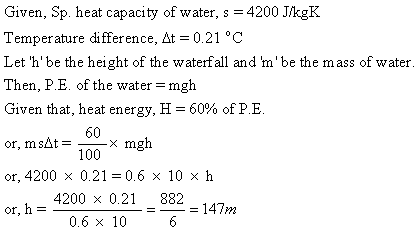
Solution 66
(b) Lever: A lever is a rigid, straight or bent bar which is capable of turning about a fixed axis.
(c) Mechanical advantage (M.A.): The ratio of the load to the effort is called the mechanical advantage of the machine.
(d) Velocity ratio (V.R.): The ratio of the velocity of effort to the velocity of load is called the velocity ratio of the machine.
It is also defined as the ratio of the displacement of effort to the displacement of load.
(e) Efficiency: Efficiency of a machine is the ratio of the useful work done by the machine to the work put into the machine by the effort. In other words, it is the ratio of the work output to the work input.
Solution 67
E.g. of class I lever with M.A. = 1: A physical balance has both arms equal (i.e. effort arm = load arm), thus its M.A. = 1
E.g. of class I lever with M.A. = 1: A pair of scissors used to cut a piece of cloth has blades longer than the handle (i.e. effort arm is shorter than the load arm), thus its M.A. = 1.
E.g. of class I lever with M.A. = 1: Shears used for cutting thin metal sheets have much longer handles as compared to the blades (i.e. effort arm is longer than the load arm), thus its M.A. = 1 and it serves as a force multiplier.
Force, Work, Energy and Power - Exercises and MCQ Exercise 61
Solution 68
Solution 69

Solution 70
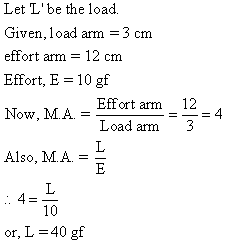
Solution 71

Solution 72
